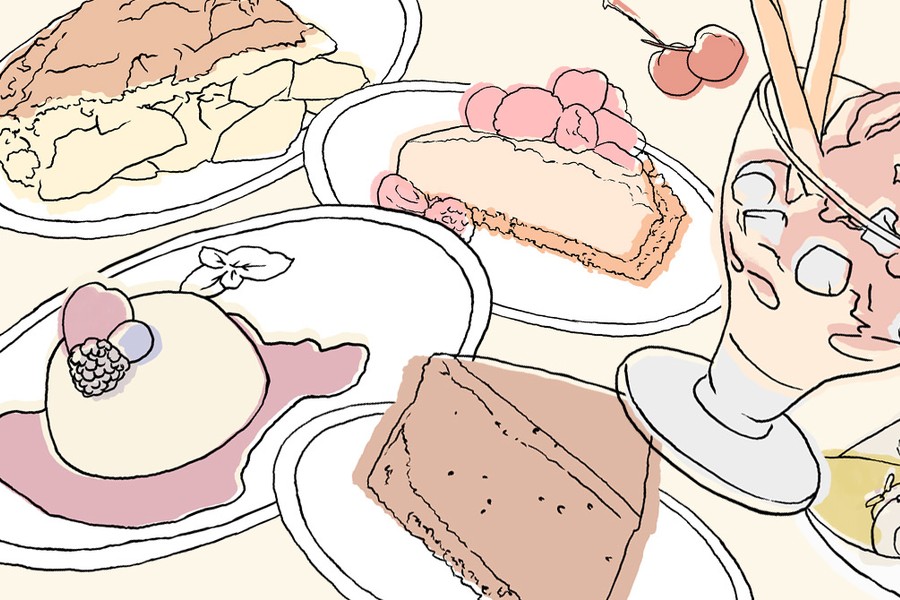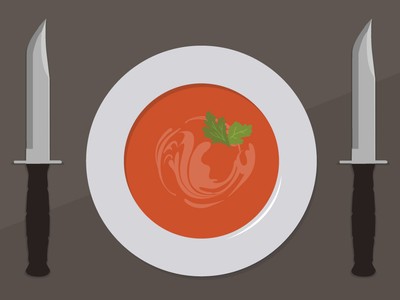The publisher of Talking Food Magazine refuses to countenance any word other than ‘pudding’. He has a point: it’s a good strong down-to-earth word with nothing but positive associations. However, it also has a specific meaning that doesn’t sit well with some of the lighter and more whimsical confections it’s required to designate, so I’m afraid he’s overruled. ‘Afters’ remains in common use – at least in the UK – but is frankly (how to put this politely?) to some a little too demotic. ‘Sweet’ suffers from the same problem as pudding, in that it doesn’t accommodate lemon or gooseberry, to pick two obvious examples of last-course staples (and to the latter of which we shall return). So, in the absence of a persuasive alternative and despite the suggestions of pretension or affectation – or in plain English ponciness – some feel it carries, we’ll be sticking with dessert.
The word itself is derived from the French ‘desservir’, to clear the table, referring to the edibles served after the table had been cleared of other dishes. Its first known use in English was in 1600, in the "Naturall and artificial Directions for Health" of William Vaughan: the fact that it had been eschewed by such robust earlier writers as Chaucer and Spenser might indicate that Vaughan was himself showing off a little by using it. Until the twentieth century it was used strictly in this sense, only acquiring its current meaning as the last course of a meal when ‘service à la Russe’ – the meal presented in distinct courses – replaced the variety of dishes presented simultaneously under ‘service à la Francaise’ as the general rule in Western society.
Old school classics never go out of style.
For many, dessert retains its sense of a luxurious, even slightly sinful, self-indulgence after the serious business of eating. There’s little doubt that this is a cultural phenomenon: Herodotus, the father of Sunday Supplement journalism, noted with amazement that among the Persians the savoury dish was merely a prelude to an array of sweet and stickies, which probably also explains why most diners wave an airy hand at the dessert menu when dining à la Grecque. Schooled in the more austere traditions of Greece and Rome, we Europeans gave much more ‘seriousness’ to savoury courses, and it is also a matter of historical record that access to the sweetening agents essential to most desserts only became widespread in these regions in the Middle Ages. After which, a tradition arose of fruit whose natural acidity was tempered by sweetness (the first apple pie recipe dates from 1318) and baking, hitherto a method used only to make bread, being applied to a wide variety of honey- then sugar-sweetened pastries. Today a meal without dessert, even if fastidiously and recklessly spurned, is now unthinkable.
But the nagging issue remains. We recognise the act of eating, however pleasurable we make it, with providing fuel for hungry muscles and blood. Apart from celebrating the simple joy of being alive (which is no small thing in itself) what’s with dessert? As executive Head Chef Luke Matthews has been wowing discerning diners at Chewton Glen since 2003: whom better to provide answers to a few key questions?
We begin by asking the Big One, the philosophical question: what, for you, is the purpose of the dessert course?
Luke’s response is straightforward, and reflects the experience of the vast majority of diners: “Finishing the meal with something sweet balances out the flavours from the previous courses.” As to what a good dessert should always demonstrate – well, ask a top chef a stupid question and be grateful for an answer that doesn’t actually make a point of your idiocy: “A good balance of texture and flavour and be visually strong”. The choice of dessert should reflect the previous course or courses: “If you’re having a filling main course it is important to have a lighter option for dessert. Seasonal is important as well: game followed by strawberries just doesn’t seem to work. We are always using products that are in season, a lot of them grown in our own kitchen garden. When people dine alfresco in the summer months, we like to offer them a dessert that reflects the weather – light, cooling and fresh for when people are feeling warm. Similarly in the winter months, we aim to offer a great range of warming and filling winter options.”
Is there a favourite dessert Luke goes back to time and time again? “Chocolate fondant or a summer pudding, or best of all a classic crumble. Old school classics never go out of style: they also sell the best when we feature them on the menu.” Now we’re talking pudding: what’s the best you’ve ever eaten? “Chocolate Fondant by Michel Bras at Le Suquet at Laguiole”.
Has he noticed fashions in desserts over his career? “They’ve become more eye-catching, more photo-worthy. People love to take pictures of their food these days, especially dessert, so we focus on making them look as good as they taste. Innovations in flavours, such as salted caramel, and using spices that reflect international influences. But as I say, old school is still the most popular.”
As tactfully as possible we break it to him that he’s to be hanged in the morning: what dessert does he select for his last meal, and will he be cooking it himself. It seems Luke is planning on taking his last night off. “No, not cooking it myself. Laverstoke Park ice cream. Salted Caramel, simple yet delicious.” We’ll allow the naked product placement, and hope he’ll be suitably rewarded. And finally, is there a dessert he’d really rather never eat again? “Anything with gooseberries. I really don’t like them.” And on that bombshell – actually, no: we can’t let that go. What on earth is wrong with the man?
This article first appeared in Talking Food Magazine, a new publication sponsored by JM Finn which aims to inspire readers to explore some of the more intricate recipes usually found in professional kitchens at home. For more insights and recipes from some of the country’s top chefs visit www.talkingfoodmagazine.co.uk.

_1.jpg)

